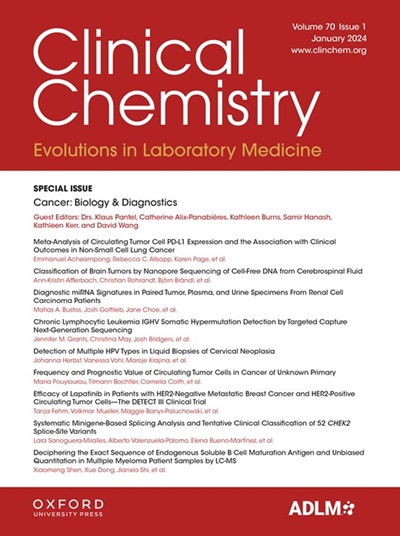Biological Variation of Erythrocyte Total, Metal-Free, and Zinc Protoporphyrin IX in Patients with Erythropoietic Protoporphyria and Healthy Subjects: Implications for Clinical Interpretation and Monitoring
IF 7.1
2区 医学
Q1 MEDICAL LABORATORY TECHNOLOGY
引用次数: 0
Abstract
Background There is a lack of robust biological variation (BV) data for porphyria-related biomarkers. Our study aimed to estimate BV of erythrocyte total, metal-free, and zinc protoporphyrin IX in patients with erythropoietic protoporphyria (EPP) and healthy subjects and to explore the clinical implications of these data. Methods Fourteen patients with EPP and 15 healthy subjects were sampled quarterly for 2 years, and erythrocyte protoporphyrin analyses were performed in duplicate in all samples. A Bayesian method was used to estimate the within-subject (CVI) and personal (CVP(i)) BV. Results Based on clinical and laboratory assessments, EPP patients were stable during the study, with only 2 data points excluded. CVI in the EPP cohort was estimated as 9.8% (95% credible interval 8.5%–11.5%) for erythrocyte total protoporphyrin, 10.5% (9.0%–12.3%) for metal-free protoporphyrin, and 5.9% (4.3%–8.0%) for zinc protoporphyrin. Baseline metal-free protoporphyrin ranged from 6.9 to 139.8 µmol/L, but the CVP(i)s derived for each patient were similar (20th and 80th percentile of predicted distribution 9.5%–11.5%), and data were homogeneously distributed. Metal-free protoporphyrin was not measurable in the healthy cohort. Data for zinc protoporphyrin were heterogeneously distributed in both study cohorts. Conclusions The EPP patients had different set points for metal-free protoporphyrin, but the CVP(i) was similar, supporting the use of the same treatment goals when monitoring. This study is the first to use Bayesian analysis to demonstrate that personal BV is similar in patients with stable, chronic disease and different set points.红细胞总、无金属和锌原卟啉IX在促红细胞生成性原卟啉症患者和健康人中的生物学变化:对临床解释和监测的意义
背景卟啉症相关生物标志物缺乏可靠的生物变异(BV)数据。本研究旨在估计红细胞总、无金属和锌原卟啉IX在红细胞生成性原卟啉症(EPP)患者和健康受试者中的BV,并探讨这些数据的临床意义。方法连续2年每季度抽取14例EPP患者和15例健康对照者,重复进行红细胞原卟啉分析。采用贝叶斯方法估计受试者内(CVI)和个人(CVP(i)) BV。结果根据临床和实验室评估,EPP患者在研究期间是稳定的,只有2个数据点被排除。EPP队列中红细胞总原卟啉CVI估计为9.8%(95%可信区间为8.5%-11.5%),无金属原卟啉CVI为10.5%(9.0%-12.3%),锌原卟啉CVI为5.9%(4.3%-8.0%)。基线无金属原卟啉范围为6.9 ~ 139.8µmol/L,但每个患者的CVP(i)s相似(预测分布的第20和第80百分位数为9.5% ~ 11.5%),数据分布均匀。在健康队列中未检测到无金属原卟啉。原卟啉锌的数据在两个研究队列中分布不均。结论EPP患者无金属原卟啉的设定点不同,但CVP(i)相似,支持监测时使用相同的治疗目标。本研究首次使用贝叶斯分析证明了稳定期、慢性疾病和不同设定点患者的个人BV相似。
本文章由计算机程序翻译,如有差异,请以英文原文为准。
求助全文
约1分钟内获得全文
求助全文
来源期刊

Clinical chemistry
医学-医学实验技术
CiteScore
11.30
自引率
4.30%
发文量
212
审稿时长
1.7 months
期刊介绍:
Clinical Chemistry is a peer-reviewed scientific journal that is the premier publication for the science and practice of clinical laboratory medicine. It was established in 1955 and is associated with the Association for Diagnostics & Laboratory Medicine (ADLM).
The journal focuses on laboratory diagnosis and management of patients, and has expanded to include other clinical laboratory disciplines such as genomics, hematology, microbiology, and toxicology. It also publishes articles relevant to clinical specialties including cardiology, endocrinology, gastroenterology, genetics, immunology, infectious diseases, maternal-fetal medicine, neurology, nutrition, oncology, and pediatrics.
In addition to original research, editorials, and reviews, Clinical Chemistry features recurring sections such as clinical case studies, perspectives, podcasts, and Q&A articles. It has the highest impact factor among journals of clinical chemistry, laboratory medicine, pathology, analytical chemistry, transfusion medicine, and clinical microbiology.
The journal is indexed in databases such as MEDLINE and Web of Science.
 求助内容:
求助内容: 应助结果提醒方式:
应助结果提醒方式:


